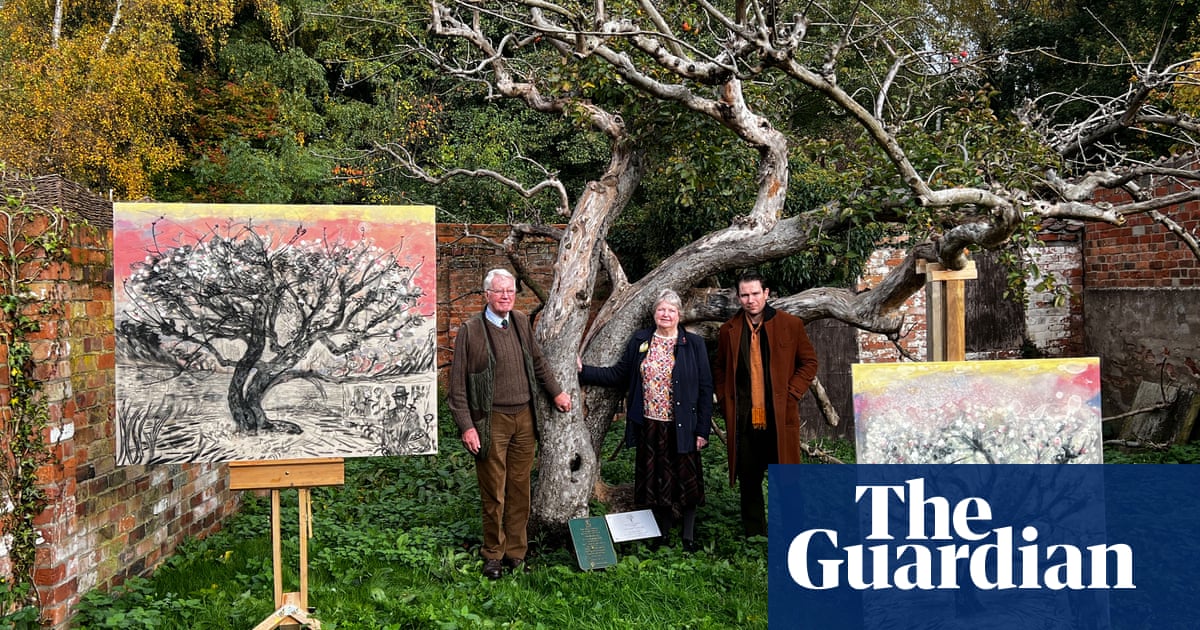It is the mother tree of perhaps the most popular cooking apple in the world. But the original bramley apple has been neglected and barred from public view, according to descendants of the gardener who discovered it.
The 220-year-old apple tree is still fruiting in the garden of a cottage in Southwell, the Nottinghamshire village that on Saturday hosts an annual festival celebrating the bramley apple.
But Celia Stevens, great-granddaughter of Henry Merryweather, the man who first spotted the potential of the unique hybrid apple, says the owners of the cottage garden, Nottingham Trent University, are neglecting the tree.
According to Stevens, the tree is surrounded by nettles, with honey fungus, a pathogen that is slowly killing the ageing tree, allowed to run rampant.
âWhen the university bought the cottage we thought, oh wonderful, they can now take care of the tree and the public can see its importance and what it represents,â she says. âBut itâs surrounded by nettles and I even saw some honey fungus when I was allowed to visit it. Itâs a tiny garden and its surrounds do not reflect this wonderful tree and what itâs done for our country.â
The cottages that come with the garden, which were purchased by Nottingham Trent University in 2018, are used as student accommodation and there is no public access to enjoy the tree.
The artist Dan Llywelyn Hall has painted the tree and will be raising money from the sale of prints of his paintings to present a fund to the university to pay for a maintenance programme for the tree and provide more public access.
He says: âItâs appalling that itâs not open to the public. The university keeps saying the tree is about to die and itâs not going to last another year but itâs in very good shape and is still fruiting. I was pleasantly surprised when I saw it but itâs very neglected and in an unloved state. The surrounding garden is in a bad state.â
Every single bramley apple ever eaten can be traced back to the tree, which was planted from a pip by a young girl, Mary Ann Brailsford, in the early 19th century. Brailsford moved out of the house after she married, and did not live to see the fame of the bramley apple.
The apple was discovered and first sold by Merryweather in 1876, and was named after a later owner of the house and tree, Matthew Bramley.
Merryweather grew grafts from the original tree and successfully produced more bramley apples. Nicknamed the âKing of Covent Gardenâ, the bramley became the only British cooking apple available all year round, its natural acidity adored by cooks.
In 2002 the Queenâs golden jubilee cited the original tree as one of the 50 âgreat British treesâ in recognition of its national heritage. For the platinum jubilee of 2022, the bramley was one of 70 ancient trees dedicated to the Queen.
Llywelyn Hallâs newly unveiled painting, Swansong of the Mother Bramley, is on show in Southwell Minster during the bramley apple festival. Prints can be purchased via a crowdfunding page to help rescue the tree.
A Nottingham Trent University spokesperson said: âThe university is incredibly proud to be custodian of the original bramley apple tree and recognises its significance to the local and wider community. The tree was dying due to an incurable honey fungus infection when NTU became its custodian and it has already outlived its natural life span by quite some time. At some point it will perish due to disease.
âDespite this, the tree still bears fruit and the university continues to work hard to look after it to try to prolong its life ⦠While the tree sits in a private garden, which the university maintains, we open it up for members of the public upon request and also for events, such as the annual Heritage open day and bramley apple festival.â
after newsletter promotion
Five unusual apple varieties
The bloody ploughman
The secret to a successful apple is a good origin story. This historic variety, first described in 1883, was said to have grown from a bag of apples stolen by a ploughman who was shot for stealing. The resulting seedling was supposedly saved and nurtured by a fellow labourer. It sounds too perfect to be true, especially when its apples are naturally coloured a vivid blood-red.
Flower of Kent
This ancient variety â a red cooking apple rival to the bramley â is from Isaac Newtonâs apple tree. Newton developed his theory of gravity supposedly after watching an apple fall from the tree outside his window at Woolsthorpe Manor in Lincolnshire. Despite being blown down by a storm in 1820, the tree regrew from its original roots and numerous descendants and clones can be found â especially within universities â worldwide.
The bardsey apple
Residents of Ynys Enlli had enjoyed the fruits from a knobbly tree on the tiny Welsh island for generations before they were spotted by Ian Sturrock, a holidaying fruit tree expert. The apple was declared the worldâs rarest variety when it was examined by experts and cuttings were taken from the tree the following spring to propagate more of the fruit. The bardsey apple, noted for its lemony aroma and flavour, could be the survivor of an orchard nurtured by monks who moved to the holy island more than 1,000 years ago.
The bastard foxwhelp
This variety is a small cider apple originating in Herefordshire. It sounds like an internet hoax but it was catalogued in the Herefordshire Pomona (1878-84). A small round apple, it has a smooth, glossy skin washed with bright red and darker stripes on the sun-exposed face. The origin of the name is unknown.
Roger Deakinâs Kazakhstan apple
Roger Deakin was a co-founder of the charity Common Ground, which launched Apple Day in 1990 to celebrate the thousands of local, historic apple varieties, many of which were in danger of being obliterated by tasteless supermarket-friendly fruit. On a trip to Kazakhstan, to research the wild ancestors of all domesticated apples, he pocketed some pips belonging to the ur-apple, Malus sieversii. Potted by Deakin, and rescued after his death by his successors, one tree planted by his friend Robert Macfarlane in a Cambridge garden continues to bear fruit.



